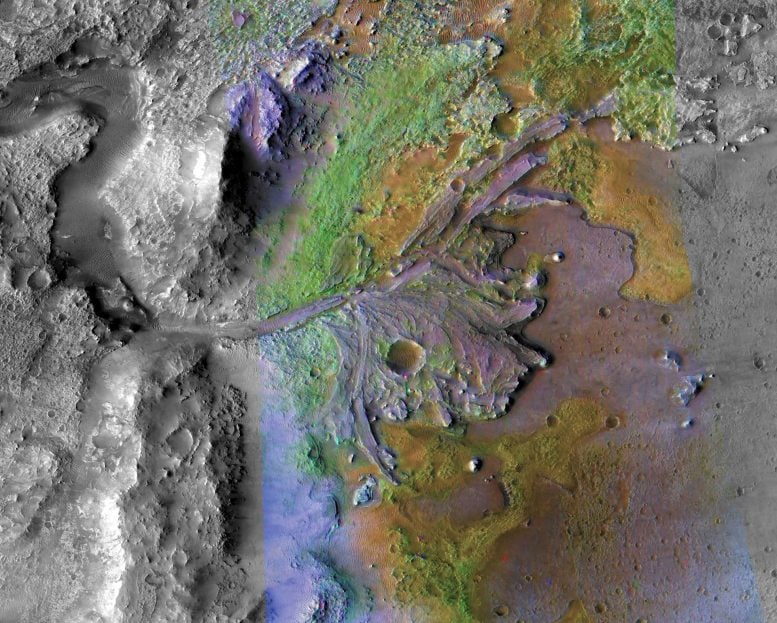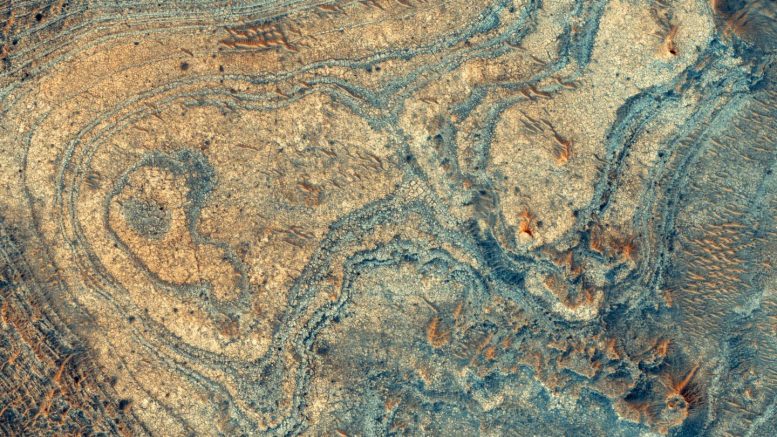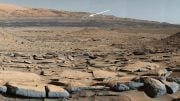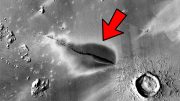
The Mars 2020 rover is headed for Jezero crater. In addition to a stunning river delta, Jezero also has exposures of the potential ashfall deposit that was the focus of this study. The rover could confirm these new findings, which will be one of the rover’s “top 10 discoveries,” says Brown professor Jack Mustard.
Ashfall from ancient volcanic explosions is the likely source of a strange mineral deposit near the landing site for NASA’s next Mars rover, a new study finds. The research, published in the journal Geology, could help scientists assemble a timeline of volcanic activity and environmental conditions on early Mars.
“This is one of the most tangible pieces of evidence yet for the idea that explosive volcanism was more common on early Mars,” said Christopher Kremer, a graduate student at Brown University who led the work. “Understanding how important explosive volcanism was on early Mars is ultimately important for understand the water budget in Martian magma, groundwater abundance and the thickness of the atmosphere.”
Volcanic explosions happen when gases like water vapor are dissolved in underground magma. When the pressure of that dissolved gas is more than the rock above can hold, it explodes, sending a fiery cloud of ash and lava into the air. Scientists think that these kinds of eruptions should have happened very early in Martian history, when there was more water available to get mixed with magma. As the planet dried out, the volcanic explosions would have died down and given way to more effusive volcanism — a gentler oozing of lava onto the surface. There’s plenty of evidence of an effusive phase to be found on the Martian surface, but evidence of the early explosive phase hasn’t been easy to spot with orbital instruments, Kremer says.

New research shows that a strange Martian mineral deposit, imaged here from orbit, was likely made by ashfall from ancient volcanic explosions. NASA
This new study looked at a deposit located in a region called Nili Fossae that’s long been of interest to scientists. The deposit is rich in the mineral olivine, which is common in planetary interiors. That suggests that the deposit is derived from deep underground, but it hasn’t been clear how the material got to the surface. Some researchers have suggested that it’s yet another example of an effusive lava flow. Others have suggested that the material was dredged up by a large asteroid impact — the impact that formed the giant Isidis Basin in which the deposit sits.
For this study, Kremer and colleagues from Brown used high-resolution images from NASA’s Mars Reconnaissance Orbiter to look at the geology of the deposit in fine detail. Kremer’s co-authors on the work are fellow Brown graduate student Mike Bramble, and Jack Mustard, a professor in Brown’s Department of Earth, Environmental and Planetary Sciences and Kremer’s advisor.
“This work departed methodologically from what other folks have done by looking at the physical shape of the terrains that are composed of this bedrock,” Kremer said. “What’s the geometry, the thickness and orientation of the layers that make it up. We found that the explosive volcanism and ashfall explanation ticks all the right boxes, while all of the alternative ideas for what this deposit might be disagree in several important respects with what we observe from orbit.”
The work showed the deposit extends across the surface evenly in long continuous layers that drape evenly across hills, valleys, craters and other features. That even distribution, Kremer says, is much more consistent with ashfall than lava flow. A lava flow would be expected to pool in low-lying areas and leave thin or non-existent traces in highlands.
And the stratigraphic relationships in the area rule out an origin associated with the Isidis impact, the researchers say. They showed that the deposit sits on top of features that are known to have come after the Isidis event, suggesting that the deposit itself came after as well.
The ashfall explanation also helps to account for the deposit’s unusual mineral signatures, the researchers say. The olivine shows signs of widespread alteration through contact with water — far more alteration than other olivine deposits on Mars. That makes sense if this were ashfall, which is porous and therefore susceptible to alteration by small amounts of water, the researchers say.
All told, the researchers say, these orbital data strongly lean toward an ashfall origin. But the team won’t have to rely only on orbital data for long. NASA’s Mars2020 rover is scheduled to land in Jezero Crater, which sits within the olivine deposit. And there are exposures of the deposit within the crater. The olivine-rich unit will almost certainly be one of the rover’s exploration targets, and it might have the final say on what this deposit is.
“What’s exciting is that we’ll see very soon if I’m right or wrong,” Kremer said. “So that’s a little nerve-wracking, but if it’s not an ashfall, it’s probably going to be something much stranger. That’s just as fun if not more so.”
If it does turn out to be ashfall, Kremer says, it validates the methodology used in this study as a means of looking at potential ashfall deposits elsewhere on Mars.
But whatever the rover finds will be important in understanding the evolution of the Red Planet.
“One of Mars 2020’s top 10 discoveries is going to be figuring out what this olivine-bearing unit is,” said Mustard, Kremer’s advisor. “That’s something people will be writing and talking about for a long time.”
Reference: “A widespread olivine-rich ash deposit on Mars” by Christopher H. Kremer, John F. Mustard and Michael S. Bramble, MAY 22, 2019, Geology.
DOI: 10.1130/G45563.1









Hello I believe that what you’re looking at needs to be expanded a small amount I’ve seen the close up of the Martian Rock which is probably very large but as a geologist I’ve seen a similar type of actually look at shark Bay in Australia they have stromatolites there I’ve been looking over all of this and I don’t disagree with the volcanoes are in the ass flow and all that but what I’m seeing is a purple blue and green witch is here commonly copper type minerals I mean there’s many of them but like Malachite and Azurite would do something and you know there’s not much atmosphere but what I think is that you need to look at the what we call the the archaea and bacteria the original bacteria that gave us our oxygen atmosphere if that’s an active volcanic site you’re probably just add do the test check for a thermophilic bacteria that might be causing the situation that you you know it’s just an additional test to see if like our black smokers which probably gave the initial start for life on this planet or maybe looking at are reminiscent of an older still active like Yellowstone where there’s still no ground wire you said heat bubbling up volcanism we can’t tell if there’s a small funerals or anything from what you’re talking about but when a Rover gets there check for the anaerobic type chemosynthetic bacteria it’s just a yeah I guess out of my mind but I seen both like up close on Mineral specimens that I study I would like to say that take my information for just a possible hunch on my part you said something might be really strange that would probably find that thermophilic bacteria or like the fossil that we found here they’re similar and what they look like I’m just like I said I got that study for 30 years and I’m looking at something that I’ve seen on Earth similarly I do teach mineral your disabled but I did teach mineralogy research I do gem identification mineral identification but obviously without samples and further tests it’s the only speculation on my part thank you for your consideration I’m probably sure that you guys have already thought of this so I would just like to see your thanks for your reading this and you know a response from email if you think that this is a justifiable thought for once occurring on Mars drop me a line back I would like to see what you think thanks again Robert Campbell retired
Robert
You said, “… what I’m seeing is a purple blue and green witch is here commonly copper type mineral …”
The article neglects to mention how the color images were created. However, as a remote sensing scientist, it is my opinion that what we are looking at is what is commonly called a “pseudo-color” image, where three bands of different wavelengths are displayed in colors other than their true colors; if they are using one or more bands from the infrared (IR) region of the EM spectrum, then they actually have no corresponding visible color. That is one of the reasons for using pseudo-color displays. IR is scattered less in dusty atmospheres than visible light, and the reflectivity tends to more diverse than in visible light, where iron-bearing minerals tend to be shades of green or red. Therefore, one or more IR bands are commonly used and the apparent colors have to be calibrated against natural color standards. Generally speaking, most things on Mars are red because the iron in the minerals is oxidized.
This is Robert Campbell again- I am sorry I regret having to use voice app.-typing is difficult(obviously voice is not great for complex ideas) the place where you see (wire) is supposed to be(WATER),funeral=fumerole sorry and Yellowstone definitely has lots of groundwater that’s why we have all the thermal features. I’ve not heard of “proof” of availability of liquid ground you probably have evidence, by simple deduction there is frozen water caps at the poles,”internal heat and assumed volcanism”. The arsaid why you should be water and the archaeon-bacteria blue green algae in the multiples of grew during that time but my apologies that I didn’t read it before I sent it and my sole basis for the hypothesis is what I observed at Yellowstone like the Morning Glory pool does it with copper sulfate(breaking disulfide bonds for energy ridding copper to prevent Cu toxicity.Again we’re talking about different planet that has a poor atmosphere-after researching Earth’s archaeon and the thermophilic bacteria both “black smokers” and Yellowstone’s thermophilic entities. It is not a hypothesis I think it is worth a more than a curious look- These organisms can withstand and thrive in the most toxic, high temp. environments. The meteorite with the possible Martian bacterium found (they do look similar to some fossil therr
STROMATOLITE-I can send a few samples for fossil comparison- additionally the last living group of stromatolites as I mentioned before is in north-east corner of Australia, near Cairns in Shark Bay Low tide exposes them, they resemble decaying tree stumps The top layer is the most diverse. Comparison may be useful for later comparison If there is a way to sample the area, (I feel that simple microscopy will reveal a lot to you [or nothing]- There is a potential for a long awaited answer-(with the Earth’s samples, compared to a direct core sample from your Martian area) when in the rover-lab- if it finds your sample has out gassing (possible metabolism), but if it ” moves, or shows any sign of reproduction- You may prove EXTRATERRESTRIALS EXIST-AND IT IS PROBABLY NEXT DOOR- on Mars- sorry to anyone who is hopeful for a close encounter with advanced species-if verified you will be the first to prove ” Life can and does exist on at least on one planet other than Earth Sorry for the lengthy comments but this is the first time in my academic life- you are a few tests away from proving your hypothesis to the scientific world life exists on at least one other planet!! An amazing discovery!! If possible let me know what you think, again sorry for the typos in my first comment. Thanks Robert Campbell.